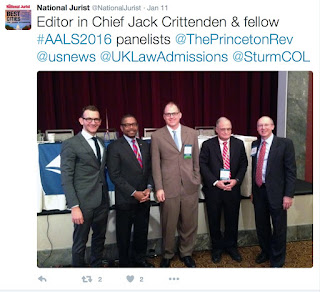I know that some discontented law students and grads have been heard to whine or growl about useless law school career services professionals. And that is a doggone shame because these canine, I mean canny, career companions can actually offer much food, or puppy chow, for thought.
Take, for instance, Santa Clara University School of Law Assistant Dean for Law Career Services Vicki Huebner’s remarkable September 16, 2015 post on her school’s Career Management blog, entitled "What I Learned About Finding a Job in the Legal Profession from My Dog’s Groomer."
Take, for instance, Santa Clara University School of Law Assistant Dean for Law Career Services Vicki Huebner’s remarkable September 16, 2015 post on her school’s Career Management blog, entitled "What I Learned About Finding a Job in the Legal Profession from My Dog’s Groomer."
In this post, Dean Huebner explains that the practices of her favorite dog groomer correspond to the skills or strategies needed to successfully obtain legal employment. Dog grooming and law job hunting are analogous in three crucial regards: (1) being excellent in the substance of one’s work; (2) branding one’s own market niche; and (3) developing one’s professional relationships.
From Huebner’s post:
- "What occurred was not only an excellent grooming session for Gabriel [Dean Huebener's prize Shepland Sheepdog], but a lesson for me on how to apply the principles of thinking like a business owner to the job search strategy."
- "There is no question that Juan is an excellent groomer. Just in case I had any doubts, Juan took pictures of Gabriel before and after his grooming sessions. . . . The quality of Juan’s work is the foundation for building his book of business and retaining clients. Likewise, legal job seekers need to demonstrate their ability to engage in the practice of law at a high level. Their attention to detail, demonstrated analytical skills, ability to articulate thought, and clear and concise writing is the foundation to be considered for employment opportunities. Law students should actively seek opportunities to enhance their practice related skills. . . "
- "Juan's salon was not the grooming environment I was used to. Juan wants to have a high-end dog grooming business. It is clear from the moment you enter his salon that he is branding himself to be that. . . . Similarly, job seekers have to consider whether or not they are communicating a brand which is conducive to the job market they are trying to enter. In other words, do they "look the part" on their cover letters, resumes, and job interviews."
- "Juan, Gabriel, and I have longstanding relationships. . . . Networking is not about asking for things (e.g. contacts, referrals, and a job). It's about building longer lasting relationships."
- "Thanks to Juan, Gabriel looks and smells great once again! More important for me, a visit to Juan’s salon reinforced key strategies about how to advance a job search."
You know, one could write a virtually identical post by identifying the general practices of any successful small businessperson, not just the owner of a high-end pet salon. What is more, one could analogize job hunting or practicing law to almost any activity that requires a modicum of organization, skill, or commitment.
Therefore, if a career services dean enjoys some absorbing little hobby, interest, or lifestyle choice, then he or she can use that to articulate or frame his or her career advice. All it takes is sufficient shamelessness plus a facility for artfully embedding trendy business buzzwords in one's bullshit, I mean dogshit, professional counsel. The kids won't realize until it is too late that they have been scammed, indeed mocked.
On the other paw, the job placement record of Santa Clara School of Law and Kennel of Justice speaks, or rather barks, for itself. For the Class of 2014, 35.2% of Santa Clara Law grads obtained non-solo full-time law jobs within 10 months of graduation. Now, relative to other law schools, this is not an impressive result– indeed, it is worse than all but 20 of the 203 ABA-accredited schools and worse than all but five of the 21 ABA-accredited schools in California. But who is to say that the remaining 64.8% are not making a JD-Advantage fortune shampooing dogs?





